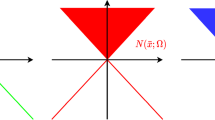Abstract
The usual theory of duality for linear fractional programs is extended by replacing the linear functions in the numerator and denominator by arbitrary positively homogeneous convex functions. In the constraints, the positive orthant inR n is replaced by an arbitrary cone. The resultant duality theorem contains a recent result of Chandra and Gulati as a special case.
Similar content being viewed by others
References
Rockafellar, R. T.,Convex Analysis, Princeton University Press, Princeton, New Jersey, 1970.
Chandra, S., andGulati, T. R.,A Duality Theorem for a Nondifferentiable Fractional Programming Problem, Management Science, Vol. 23, pp. 32–37, 1976.
Schechter, M.,A Solvability Theorem for Homogeneous Functions, SIAM Journal on Mathematical Analysis, Vol. 7, pp. 696–701.
Mond, B., andSchechter, M.,A Programming Problem with an L p Norm in the Objective Function, Journal of the Australian Mathematical Society, Vol. 19, Series B, Part 3, pp. 333–342, 1976.
Author information
Authors and Affiliations
Additional information
Communicated by O. L. Mangasarian
The authors wish to thank the referee for a number of valuable suggestions, particularly improvements in Theorem 3.4 and Corollary 3.1.
Rights and permissions
About this article
Cite this article
Mond, B., Schechter, M. A duality theorem for a homogeneous fractional programming problem. J Optim Theory Appl 25, 349–359 (1978). https://doi.org/10.1007/BF00932898
Issue Date:
DOI: https://doi.org/10.1007/BF00932898



